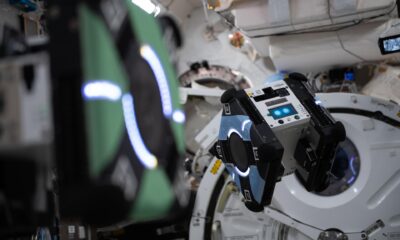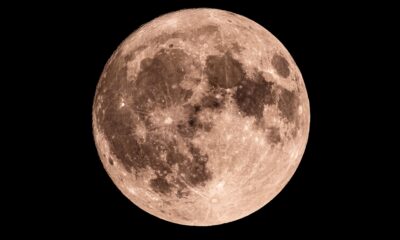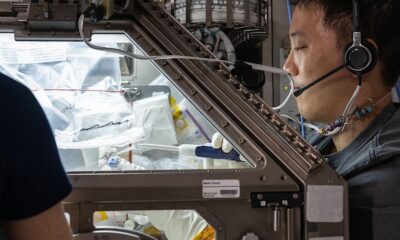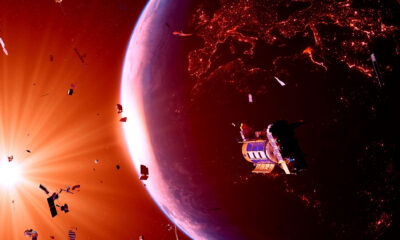Science
Curiosity Rover Explores Martian Ridge for Scientific Insights

NASA’s Curiosity rover has successfully captured images while stationed at a fracture wall known as “Río Frío.” On August 19, 2025, during Sol 4634 of its mission, Curiosity utilized its Left Navigation Camera to document its surroundings, marking a significant moment in its exploration of the Martian terrain.
Curiosity’s efforts at Río Frío are part of a broader investigation into the unique geology of the region. The rover’s observations aim to uncover the internal structure and chemical composition of the ridges that dominate the boxwork terrain. These insights could illuminate the processes that have allowed these geological formations to stand out against surrounding landscapes.
Scientific Investigations and Findings
The science team has planned extensive imaging and analysis to deepen their understanding of this area. Large Mastcam mosaics will be created to document the ridge from its base to the summit, while a MAHLI mosaic will focus on the horizon of the wall. This horizon exhibits resistant nodules and smooth surfaces, which scientists believe may represent ancient mineral veins. The target for this analysis, dubbed “Jardín de las Delicias,” is anticipated to provide a wealth of data regarding Martian geology.
To further explore the chemical properties of these formations, the rover will conduct detailed analyses using the Alpha Particle X-ray Spectrometer (APXS) on a nodule-filled target named “Minimini.” Additionally, the SuperCam will analyze a vein at the site called “El Tapado.” This combination of visual and chemical investigations is crucial for building a comprehensive narrative about the ridge’s formation and history.
Ongoing Exploration
In addition to studying Río Frío, Curiosity’s mission includes imaging other noteworthy geological features nearby. The rover will capture images of the “Paniri” and “Mishe Mokwa” buttes using the Mastcam and ChemCam, respectively. This ongoing exploration is vital for understanding the Martian environment and the historical processes that have shaped it.
The rover’s suite of instruments, including the Dynamic Albedo of Neutrons (DAN), Radiation Assessment Detector (RAD), and Rover Environmental Monitoring Station (REMS), will continue to monitor environmental conditions. These instruments play a key role in ensuring that Curiosity can adapt its investigations to changing Martian conditions.
Curiosity’s next drive will take it toward a smaller ridge that runs perpendicular to Río Frío. The mission team, led by Michelle Minitti, Deputy Principal Investigator for the Mars Hand Lens Imager (MAHLI), remains committed to uncovering the secrets embedded within these Martian ridges, which may hold clues about the planet’s past.
As the rover continues its journey, the scientific community eagerly anticipates the discoveries that will emerge from this rich and diverse Martian landscape.
-

 Technology5 months ago
Technology5 months agoDiscover the Top 10 Calorie Counting Apps of 2025
-

 Technology3 weeks ago
Technology3 weeks agoOpenAI to Implement Age Verification for ChatGPT by December 2025
-

 Health3 months ago
Health3 months agoBella Hadid Shares Health Update After Treatment for Lyme Disease
-

 Health3 months ago
Health3 months agoAnalysts Project Stronger Growth for Apple’s iPhone 17 Lineup
-

 Health4 months ago
Health4 months agoErin Bates Shares Recovery Update Following Sepsis Complications
-

 Technology5 months ago
Technology5 months agoDiscover How to Reverse Image Search Using ChatGPT Effortlessly
-

 Technology3 months ago
Technology3 months agoElectric Moto Influencer Surronster Arrested in Tijuana
-

 Technology5 months ago
Technology5 months agoMeta Initiates $60B AI Data Center Expansion, Starting in Ohio
-

 Technology2 months ago
Technology2 months agoDiscover 2025’s Top GPUs for Exceptional 4K Gaming Performance
-

 Technology5 months ago
Technology5 months agoRecovering a Suspended TikTok Account: A Step-by-Step Guide
-

 Health5 months ago
Health5 months agoTested: Rab Firewall Mountain Jacket Survives Harsh Conditions
-

 Lifestyle5 months ago
Lifestyle5 months agoBelton Family Reunites After Daughter Survives Hill Country Floods





















